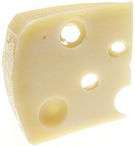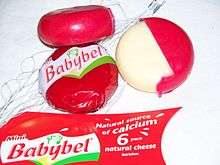This is a dynamic list and may never be able to satisfy particular standards for completeness. You can help by
expanding it with reliably sourced entries.
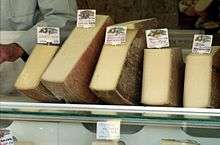
A cheese counter at a shop
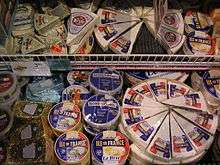
Cheese in a store cooler
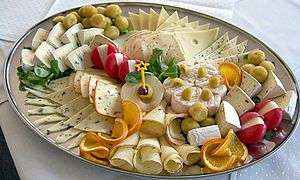
A variety of cheeses on serving platter
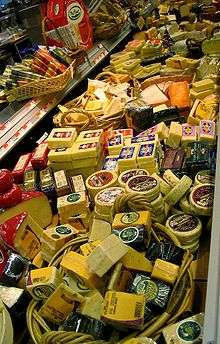
Many cheeses at a supermarket

Cheese counter, Freiburg
.jpg)
Cheese shop, Paris
This is a list of cheeses by place of origin. Cheese is a milk-based food that is produced in wide-ranging flavors, textures, and forms. Hundreds of types of cheese from various countries are produced. Their styles, textures and flavors depend on the origin of the milk (including the animal's diet), whether they have been pasteurized, the butterfat content, the bacteria and mold, the processing, and aging.
Herbs, spices, or wood smoke may be used as flavoring agents. The yellow to red color of many cheeses, such as Red Leicester, is normally formed from adding annatto. While most current varieties of cheese may be traced to a particular locale, or culture, within a single country, some have a more diffuse origin, and cannot be considered to have originated in a particular place, but are associated with a whole region, such as queso blanco in Latin America.
Cheese is an ancient food whose origins predate recorded history. There is no conclusive evidence indicating where cheesemaking originated, either in Europe, Central Asia or the Middle East, but the practice had spread within Europe prior to Roman times and, according to Pliny the Elder, had become a sophisticated enterprise by the time the Roman Empire came into existence.[1]
Africa
Benin
| Name |
Image |
Region |
Description |
| Wagasi |
|
|
It is a soft cow's milk cheese. |
|
Egypt
| Name |
Image |
Region |
Description |
| Areesh |
|
|
Originated in Egypt, it is similar to cottage cheese. Shanklish, a fermented cheese, is made from areesh cheese.[2] |
| Domiati |
|
|
A soft white salty cheese made primarily in Egypt,[3] but also in Sudan and other Middle Eastern countries. |
| Karish |
|
|
Made from Laban Rayeb, a curdled milk product |
| Mish |
|
|
A traditional Egyptian cheese that is made by fermenting salty cheese for several months or years. |
| Roumy cheese |
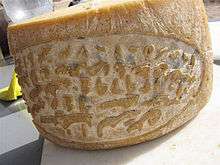 |
|
Also known as "ras cheese", roumy is one of the main types of cheese in Egypt. It has a distinctive smell, and different degrees of salty taste according to the stage of aging. |
Ethiopia
| Name |
Image |
Region |
Description |
| Ayibe |
|
|
A cottage cheese that is mild and crumbly. It has little flavor on its own, and is often served as a side dish to soften the effect of very spicy food. |
Mauritania
| Name |
Image |
Region |
Description |
| Caravane cheese |
|
|
The brand name of a camel milk cheese produced in Mauritania by Tiviski, a company founded by Nancy Abeiderrhamane in 1987. The milk used to make the cheese is collected from the local animals of a thousand nomadic herdsmen, and is very difficult to produce, but yields a product that is low in lactose. |
Asia
Armenia
| Name |
Image |
Region |
Description |
| Chechil |
|
|
A brined string cheese that originated in Armenia, it has a consistency approximating that of suluguni or mozarella and is produced in the form of dense strings, rolled up in a figure eight of thick braid-shaped ropes. |
Azerbaijan
| Name |
Image |
Region |
Description |
| Motal |
|
|
Listed by the Ark of Taste project |
Bangladesh
China
Mainstream Chinese culture is not dairy-centric. However, outlying regions of the country, such as Tibet and Yunnan, have strong cheese traditions.
Georgia
| Name |
Image |
Region |
Description |
| Sulguni |
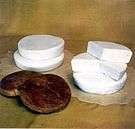 |
|
A pickled Georgian cheese from the Samegrelo region. It has a sour, moderately salty flavor, a dimpled texture, and an elastic consistency; these attributes are the result of the process used, as is the source of its moniker "pickle cheese". Its color ranges from white to pale yellow. Sulguni is often deep-fried, which masks its odor. It is often served in wedges. |
India
| Name |
Image |
Region |
Description |
| Bandel |
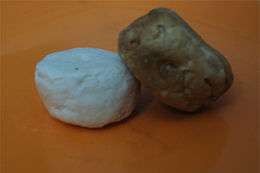 |
|
An Asian cheese that originated in a Portuguese colony Bandel located in eastern India. Today, the production is concentrated in the towns of Tarakeswar and Bishnupur, Bankura, near Kolkata, West Bengal, India.[5][6] |
| Paneer |
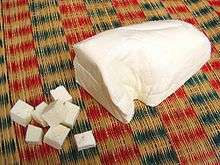 |
|
A fresh cheese common in South Asian cuisine. In eastern parts of Indian Subcontinent, it is generally called Chhena. It is an unaged, acid-set, non-melting farmer cheese or curd cheese made by curdling heated milk with lemon juice, vinegar, or any other food acids. |
| Chhena |
|
|
A fresh, unripened curd cheese made from cow or water buffalo milk. A crumbly and moist form of farmers cheese or paneer, it is used to make desserts such as rasgulla. Produced mostly in eastern Indian states of Odisha and West Bengal, it is the chief ingredient of most of the sweets produced here. It is used in various Hindu religious rituals. The earliest reference of cheese in India dates back to 1400 BCE.[7][8] |
| Dahi Chhena |
|
|
This is a cheese which is very similar to chhena in texture but has a deep, reddish-brown color. It is more flavorful and distinct in taste than chhena. It is rich in whey protein. The production of this kind of cheese has become very rare. It was generally produced in households in Cuttack region of Orissa. It is produced from the remainder of milk after butter/lahuni has been separated from the milk. The quantity of milk required to produce even small amounts of dahi chhena is thus huge. This cheese also has a long shelf life. Owing to the above two properties it could be kept in earthen sikkas for months. |
| Khoya |
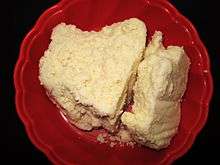 |
|
This cheese is widely used in Indian and Pakistani cuisine. It's made of either dried whole milk or milk thickened by heating in an open iron pan. It's similar to ricotta cheese, but lower in moisture.[9] |
| Kalari |
 |
|
Also known as Kiladi or Maish Krej (Kashmiri: ميش کريج,) |
| Kalimpong cheese |
|
|
Originates from Kalimpong, a hill station in the Indian state of West Bengal. When unripe, Kalimpong cheese is a little like the Welsh Caerphilly, slightly acidic and a little crumbly with a relatively smooth (edible) rind and not particularly strong-smelling. |
| Surti Paneer |
|
|
The name of this cheese is derived from the town of Surat in western India where it was probably first prepared and marketed. Once a popular product, very little of it is marketed today. It is a soft cheese prepared from water buffalo milk with crude rennet, salted and kept steeped in acid whey for 2–3 days. Surti paneer should have a fairly firm body and smooth texture with no internal cracks. It has a slightly salted, milk acid-curd flavour. |
Iran
| Name |
Image |
Region |
Description |
| Lighvan cheese |
|
Liqvan |
a brined curd cheese traditionally made in Iran. Having a sour flavor, and a shape covered by holes, the cheese is produced from sheep’s milk. The name comes from Liqvan, a village in Tabriz, where it has traditionally been made. |
| Talesh cheese |
|
Talesh |
it can only be found in Talesh county. this cheese is made out of goat or sheep milk. in tradition after the cheese being processed, it is held in sheep or goat skin to last longer. |
Japan
| Name |
Image |
Region |
Description |
| So |
|
|
So was a type of dairy product made in Japan between the seventh and 10th centuries. So was made from layers of milk skin. |
| Sakura cheese |
|
|
A soft cheese created in Hokkaidō, Japan. It is creamy white and flavored with mountain cherry leaves. Sakura means "cherry blossom" in Japanese. |
Mongolia
| Name |
Image |
Region |
Description |
| Byaslag[10] |
|
|
Prepared with cow or yak milk, this cheese has a lumpish curd and is somewhat sour in flavor.[10] |
There are two types of Mongolian cheese (бяслаг). They are similar in taste and are like a cross between mozzarella and an unsalted feta cheese.
түүхий сүүний - this is a creamy version of Mongolian cheese made by boiling the milk and keeping the cream top.
болсон сүүний - this is similar but is made without the cream.
Nepal
| Name |
Image |
Region |
Description |
| Flower of Rajya |
|
|
A firm yak's-milk cheese made in Nepal by Tibetan nomads in collaboration with the Trace Foundation. Milk is heated and ripened in big copper vats, curdled, drained and molded into 10-12 pound wheels. The cheese is dry-cured in Tibetan red salt, aged, then wrapped in scarves and packed in bamboo baskets. |
| Chhurpi |
 |
|
A yak's-milk cheese, influenced by Tibetan cuisine. Depending on how it is prepared, Chhurpi can be either hard and chewy, or soft. |
Philippines
| Name |
Image |
Region |
Description |
| Kesong puti |
 |
|
A soft, white cheese, similar to cottage cheese, made from unskimmed carabao's milk, salt and rennet.[11] It has a soft, close texture and slight salty taste. |
South Korea
| Name |
Image |
Region |
Description |
| Imsil |
|
|
Imsil Cheese Village is located near the town of Imsil (within the county of Imsil). It offers one day or more vacation program for children and tourists to learn how to make cheese. The cheese produced there is called Imsil cheese, following the county name. |
Europe
Austria
| Name |
Image |
Region |
Description |
| Bachensteiner |
|
|
|
| Bergkäse |
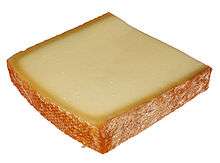 |
|
A group of cheeses produced in the Alps |
| Brimsen |
|
|
An Austrian term for Bryndza |
| Gelundener Käse |
|
|
|
| Lüneberg cheese |
|
|
A cow's-milk cheese made in mountain valleys in Vorarlberg in western Austria.[12] |
| Montafoner Sauerkäse |
|
|
|
| Mondseer |
|
|
Made from pasteurized milk, Mondseer is a semi-solid cheese similar to Muenster cheese or Limburger. The surface is brushed by hand with salt water red smear, and maturation takes four to six weeks. The fat content is 45%. It has a mild to slightly spicy aroma and a sweet and sour taste. Its natural rind is yellow-orange in color. |
| Staazer |
|
|
|
| Steirerkäse |
|
|
|
| Tyrolean grey (Tiroler Graukäse) |
 |
|
A strongly flavored, rennet-free cows-milk cheese made in the Zillertal, Austria. It owes its name to the grey mould that usually grows on its rind. It is extremely low in fat (around 0.5%), yet it has a powerful penetrating smell. |
Belgium
| Name |
Image |
Region |
Description |
| Brussels cheese |
|
|
Made from cow's milk, it has a smooth texture and a sharp and citrus flavor, along with a strong and salty bite. |
| Chimay cheeses |
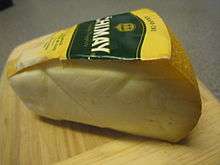 |
|
brands, and varieties, of cheeses produced by Chimay Brewery, some soaked in Chimay Ale. |
| Herve cheese |
.jpg) |
|
An aged cheese made from unpasteurized cow's milk. It is traditionally aged in humid caves. |
| Le Wavreumont[13] |
|
|
Produced from cow's milk, this cheese is semi-soft and its coloration varies from yellow to ivory depending upon the season in which its produced.[13] It is made by Fromagerie des Ardennes, which is in Ferrières, Belgium.[13] |
| Limburger cheese |
 |
|
Originated during the 19th century in the historical Duchy of Limburg, which is now divided among modern-day Belgium, Germany, and Netherlands. The cheese is especially known for its pungent odor. One of the most traditional forms of eating limburger is the limburger sandwich. |
| Maredsous cheese |
|
|
A loaf-shaped cheese made from cow's milk. The cheese is lightly pressed, then washed in brine to create the firm, orange crust and pungent aroma. |
| Passendale cheese |
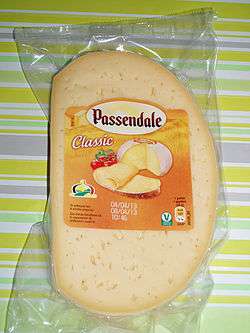 |
Passendale, Belgium |
Named for Passendale, the village where it originated, it's one of the best-known cheeses in Belgium. It resembles a loaf of bread and has a round shape and a hard, but edible brown rind with spots of white. Inside, the flesh is golden, dotted with small holes and very creamy. It has a firm and damp consistency, slightly sweet bouquet and mild flavor. The regular Passendale cheese exists in two variations called Passendale Classic and Passendale Prelude.[14] |
| Remoudou |
|
Land of Herve, Belgium |
It derives its name from the use of milk removed 15 minutes after the usual milking. Hence the wallon verb rimoûd meaning to re-milk.[15] This cheese weighs 200 to 500g. When it is washed with salt it gets a strong taste, and when it is washed with milk it keeps a mild taste. It is often sold in pieces. |
| Rodoric |
|
Liège, Belgium |
An aged cheese made from unpasteurized goat milk that's traditionally aged in humid caves. When young, the interior is sweet, with age the flavor becomes spicy. |
Bosnia and Herzegovina
| Name |
Image |
Region |
Description |
| Livno cheese |
|
Livno, Bosnia and Herzegovina |
The cheese is ready after an average of 60 to 66 days in a controlled environment. The flavor is full, and in older cheeses the taste is slightly piquant. The largest producer is Mljekara Livno or Lura Dairy d.o.o. Livno, with yearly production exceeding 500 metric tons. |
| Travnički (Vlašić) cheese |
|
Travnik, Bosnia and Herzegovina |
This is produced in mountain Vlašić in central Bosnia above the city of Travnik. It is originally made from sheep milk but there is variety made from cow milk. This cheese is white in color with small irregular holes scattered in or it can be solid without holes. Taste is dry and salty. Milk has special taste that comes from variety of different herbs that sheep are eating while grazing on the mountain Vlašić. |
Bulgaria
| Name |
Image |
Region |
Description |
| Cherni Vit |
|
Cherni Vit, Teteven Municipality, Lovech Province |
Made from sheep milk, Cherni Vit cheese owes the green color of its crust and its characteristic taste to the formation of mold. This occurs naturally due to the specific conditions in the region and the technology of production. Produced for centuries, Cherni Vit cheese was nearly extinct in the 2000s until it was rediscovered and popularized by Slow Food representatives. |
| Kashkaval |
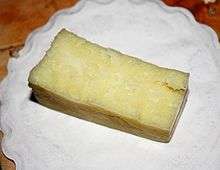 |
|
A type of yellow cheese made of sheep milk, cow milk or goat milk. In Albania, Republic of Moldova, Bulgaria, Republic of Macedonia, Serbia and Romania, the term is often used to refer to all yellow cheeses (or even any cheese other than sirene). |
| Sirene |
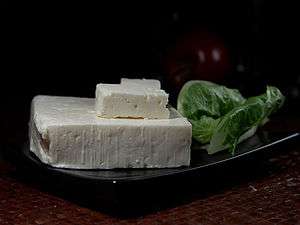 |
|
A type of brine cheese made in South-Eastern Europe, especially popular in Serbia, Bulgaria, Romania, Albania, the Republic of Macedonia and Greece. It is made of goat milk, sheep milk, cow's milk or a combination of milks.[16] It is slightly crumbly with a fat content of about 30–35%. It is commonly produced in blocks, and has a slightly grainy texture. |
Cyprus
| Name |
Image |
Region |
Description |
| Akkawi |
|
|
Commonly made using cow milk, but can be made with goat or sheep's milk, it has a smooth texture and a mild salty taste. It is now produced on a large scale in the Middle East, notably in Israel, Palestine, Lebanon, Syria and Cyprus. |
| Anari cheese |
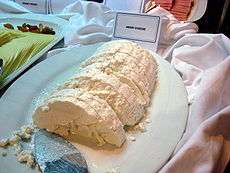 |
|
A fresh mild whey cheese produced in Cyprus. Although much less known than other Cypriot cheeses (e.g. halloumi), it has started to gain popularity following recent publicity exposure. The whey used is usually a by-product in the production process of other harder cheeses, commonly that of halloumi or kefalotyri cheese.[17] |
| Halloumi |
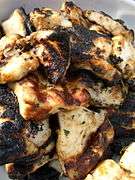 |
|
a Cypriot semi-hard, unripened brined cheese made from a mixture of goat and sheep milk, and sometimes also cow milk.[18][19][20][21] It has a high melting point and so can easily be fried or grilled. It is noted for its ability to retain its shape under direct heat, or as a "grillable" cheese. |
| Kefalotyri |
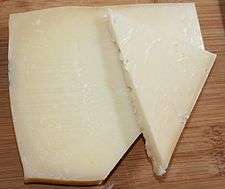 |
|
A hard, salty yellow cheese made from sheep milk and/or goat's milk in Greece and Cyprus. Depending on the mixture of milk used in the process the color can vary between yellow and white. |
Croatia
| Name |
Image |
Region |
Description |
| Paški sir |
 |
Croatian island of Pag |
A hard, distinctively flavored sheep milk cheese. It is generally regarded as the most famous of Croatian artisan cheeses and is found in many export markets outside Croatia, also known as Godsips cheese. |
| Škripavac [22][23] |
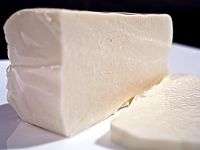 |
|
"Squeaking" cheese from Lika |
| Tounjski |
|
|
Smoked cheese from Tounj near Ogulin |
| Dimsi |
|
|
Smoked cheese from Zagreb based on Bjelovarac cheese |
Czech Republic
| Name |
Image |
Region |
Description |
| Abertam cheese |
|
|
A traditional Czech farmhouse hard cheese made from sheep milk. It has the shape of an irregular ball with thin yellow to orange natural rind. It is used as a table cheese or for melting. |
| Olomoucké syrečky |
.jpg) |
Loštice, Czech Republic This natural matured soft cheese is free of any chemical additives. |
A ripened soft cheese that is easily recognizable per its strong scent and yellowish color. It is named after the city of Olomouc and contains only 0.6% of fat. |
Denmark
| Name |
Image |
Region |
Description |
| Danbo |
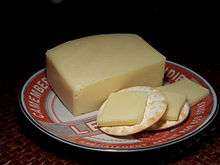 |
|
A semi-soft, aged cow's milk cheese, and a common household cheese in Denmark. The cheese is typically aged between 12 and 52 weeks in rectangular blocks of 6 or 9 kg, coated with a bacterial culture. The culture is washed off at the end of the aging cycle, and the cheese is packaged for retail sales. |
| Danish Blue |
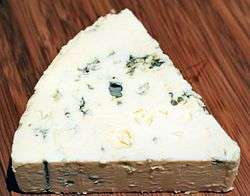 |
|
Danablu, is a strong, blue-veined cheese. This semi-soft creamery cheese is typically drum or block shaped and has a white to yellowish, slightly moist, edible rind. Made from full fat cow's milk and homogenised cream, it has a fat content of 25–30% and is aged for eight to twelve weeks |
| Esrom |
 |
|
Esrom, or Danish Port Salut cheese is a Trappist-style pale yellow semi-soft cow's milk cheese with a pungent aroma and a full, sweet flavour. It is a porous cheese, with many small holes throughout, and is slightly elastic and buttery in texture. |
| Fynbo |
|
|
A semi-hard Danish cheese named after the island of Fyn. It has a flavor of buckwheat and is processed with a combination of mesophilic and thermophilic bacterial cultures. |
| Havarti |
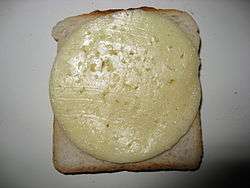 |
|
Also known as cream Havarti, a semi-soft cow's milk cheese made like most cheeses by introducing rennet to milk to cause curdling. The curds are pressed into cheese molds which are drained, and then the cheese is aged. It is a washed curd cheese, which contributes to the subtle flavor. It is interior-ripened, rindless, smooth and slightly bright-surfaced. It has very small and irregular openings ("eyes") distributed in the mass. Havarti has a buttery aroma and can be somewhat sharp in the stronger varieties, much like Swiss cheese. The taste is buttery, and from somewhat sweet to very sweet, and it is slightly acidic. |
| Maribo |
|
Lolland |
A semi-hard cheese made from cow's milk. It has a firm, dry interior; a creamy texture; and many small, irregular holes. It has a pale tan rind covered in yellow wax. Its flavour is tangy, and it is sometimes seasoned with caraway seeds. |
| Molbo |
|
Mols |
A semi-hard cow's milk cheese made in the region of Mols. It is very similar to Edam, with a delicate, light flavour that is slightly tangy and salty. It has small, regular holes and is covered in a red wax coating. |
| Saga |
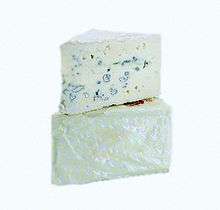 |
|
A mix of blue cheese and brie, creamy, blue-veined cheese with a white-mould rind. Saga is a very mild blue-veined cheese. It comes with a delicate blue mold, that may not appear in other varieties of blue cheeses. It is aged for more than 60 days. |
| Samsø cheese |
|
Samsø |
A cow's milk cheese named after the island of Samsø. It is similar to Emmentaler, although its flavour is milder: gentle and nutty in young cheeses and pungent with sweet and sour notes in older ones. Samsø's interior has a supple, elastic texture; a yellow colour; and a few large, irregular holes. It is the national cheese of Denmark. |
| Vesterhavsost |
|
|
|
| Tybo |
|
|
A cow's milk cheese, similar to a mild Samsø. It is loaf-shaped, with a cream-colored, holey interior and a yellow rind. It has a slightly salty, smooth, and lactic flavor. |
Estonia
| Name |
Image |
Region |
Description |
| Atleet |
|
|
Semi hard cheese with little sour flavor made from cow's milk, produced by Valio. |
| Eesti Juust |
|
|
Semi hard Dutch-type cheese made from cow's milk, produced by Estover. |
| Kadaka juust |
|
Saaremaa |
Semi hard smoked cheese made from cow's milk, produced by Saaremaa Piimatööstus. Also available with garlic. |
Finland
France
| Name |
Image |
Region |
Description |
| Kashkaval |
 |
|
A type of yellow cheese made of sheep milk. In the Republic of Macedonia the term is often used to refer to all yellow cheeses (or even any cheese other than Сирење). In English-language menus "кашкавал" is translated as "yellow cheese" (whereas sirene is usually translated as "white cheese" or simply "cheese"). The taste of the kashkaval is sometimes compared to that of the United Kingdom's cheddar cheese, although variations exist. |
| Urdă |
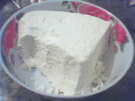 |
|
An unaged whey cheese |
| Belo Sirenje |
 |
|
A type of brine cheese produced in Republic of Macedonia called "white cheese" or simply "cheese". It is made of goat milk, sheep milk, cow's milk or a combination of milks. It is slightly crumbly with a fat content of 30–35%. It is commonly produced in blocks, and has a slightly grainy texture. |
Moldova
| Name |
Image |
Region |
Description |
| Kashkaval |
 |
|
A type of yellow cheese made of sheep milk. In the Moldova the term is often used to refer to all yellow cheeses. |
| Urdă |
 |
|
An unaged whey cheese |
| Bryndza |
|
|
A salty brined cheese made from sheep milk. |
| Brânză de vaci |
|
|
Made from whole cow milk similar to cottage cheese. |
Germany
Greece
| Name |
Image |
Region |
Description |
| Anthotyros |
|
|
A traditional fresh cheese. There are Dry Anthotyros and Fresh Anthotyros. Dry Anthotyros is a matured cheese similar to Mizithra. Anthotyros is made with milk and whey from sheep or goats, sometimes in combination. The ratio of milk to whey usually is 9-to-1. It is commonly a truncated cone, but when shipped in containers may be crumbled, as it is removed. It may be unpasturized, where law allows. |
| Chloro |
|
Santorini |
|
| Feta |
 |
Protected designation of origin (PDO) – Epirus, Macedonia, Thrace, Thessaly, Peloponnese, Lesbos |
|
| Graviera |
|
PDO – Agrafa, Crete, Naxos |
|
| Kasseri |
|
PDO – Macedonia, Thrace, Thessaly, Lesbos |
|
| Kefalograviera |
|
PDO – Crete, Sterea Ellada |
|
| Kefalotyri |
 |
|
|
| Kopanisti |
|
PDO – Mykonos |
|
| Malaka |
|
Crete |
Made from Graviera curd. |
| Manouri |
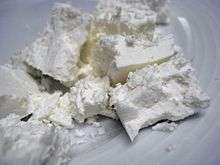 |
PDO – Thessaly |
|
| Metsovone |
|
PDO – Metsovo, Epirus |
|
| Myzithra |
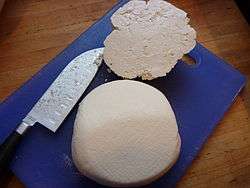 |
Crete |
|
| Tyrozouli |
|
Crete |
Made from Myzithra by adding salt, causing dehydration, and allowing maturation. |
| Xynomizithra |
|
PDO – Crete, Myconos |
|
| Xynotyro |
|
Myconos |
|
- Arseniko Naxou - (Naxos)
- Batzos, Protected designation of origin (PDO)
- Chèvre Metsovou - (Metsovo)
- Formaela, PDO - (Arachova)
- Froumaela Valmandouras - (Peloponnese)
- Galotyri, PDO - (Thessaly, Epirus)
- Kalathaki, PDO - (Limnos)
- Kalathotos
- Karikeftos
- Katiki, PDO - (Domokos)
- Krasotyri - (Kos)
- Ladenios
- Ladotyri, PDO - (Lesbos)
- Malaka - (Chania)
- Manoura Sifnou - (Sifnos)
- Mastelo - (Chios)
- Melichloro - (Lemnos)
- Metsovella - (Metsovo)
- Petroti - (Tinos)
- Pichtogalo Chanion, PDO - (Chania)
- San Michali
- Sfela, PDO - (Peloponnese)
- Stamatini
- Touloumisio
- Xygalo, PDO - (Crete)
Hungary
Iceland
| Name |
Image |
Region |
Description |
| Höfðingi |
|
|
A type of Icelandic cheese, described as a "creamy-soft, almost runny cheese with a white rind/crust and a smooth, mild flavor". |
Ireland
Italy
Latvia
| Name |
Image |
Region |
Description |
| Jāņi cheese |
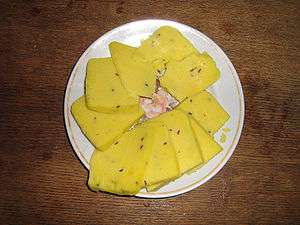 |
|
Its basics are raw quark and fresh milk, but other products can be added |
| Latvijas |
|
|
|
Lithuania
Malta
| Name |
Image |
Region |
Description |
| Ġbejna |
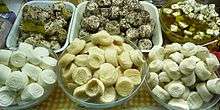 |
Commonly associated with the island of Gozo |
A small round cheese made from sheep's milk, salt and rennet, Ġbejniet are prepared and served in a variety of forms. Until the early 20th century, ġbejniet made from unpasteurised milk were one of the causes of the spread of Brucellosis which was so prevalent as to be called "the Maltese fever". |
Netherlands
The Netherlands is one of the major cheese producing countries of Europe, with a tradition of cheesemaking as shown by the Dutch cheese markets.
Norway
Poland
Portugal
| Name |
Image |
Region |
Description |
Castelo Branco cheese
(PDO) |
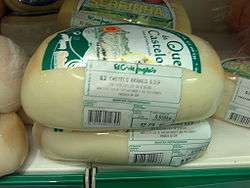 |
Beira Baixa |
a cheese named after the city of the same name in Portugal, the main city of the district where it is produced. The cheese is made from milk produced by either a goat or a ewe, and has a soft texture. |
Queijo de Nisa
(PDO) |
 |
Alto Alentejo |
a semi-hard sheep's milk cheese from the municipality of Nisa. It is created from raw milk, which is coagulated, then curdled using an infusion of thistle. |
Queijo do Pico
(PDO) |
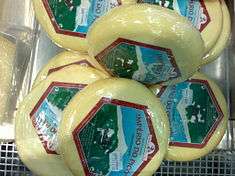 |
Azores |
Originating from the island of Pico, this cured cheese is produced in cylindrical formats from cow milk It's considered a fatty cheese and the ripening of the cheese forms a yellow exterior irregular crust and yellowish-white, soft and pasty interior. Pico cheese has a salty taste and a, characteristically, intense aroma. |
São Jorge
(PDO) |
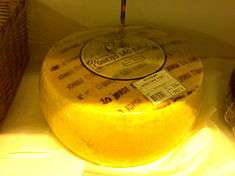 |
Azores |
Produced in the São Jorge Island, this is a hard/semi-hard cheese made from unpasteurised cow's milk, and the pâte has small eyes. |
Serra da Estrela
(PDO) |
|
Serra da Estrela |
Produced in a mountainous region this cheeses is made from sheep's milk, mostly during the months of November to March. The texture of the paste varies depending on its age, from a very soft semi-liquid when young, to a soft but sliceable solid when older. It is a cured cheese created by artisanal producers with a white or slightly yellow color and a uniform creamy consistency with at most a few small holes in it. |
| Requeijão |
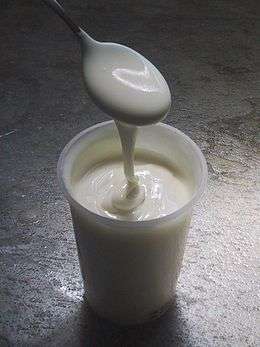 |
|
|
Saloio
(Brand) |
|
|
|
| Santarém cheese |
|
|
|
Romania
| Name |
Image |
Region |
Description |
| Brânzǎ de burduf |
 |
|
A salty type of cheese prepared with sheep's-milk, it has a strong flavor and is slightly soft in texture. To obtain it, sweet caş is cut into small pieces, salted and then hand-mixed in a large wooden bowl. The mixture is then placed in a sheep’s stomach, or into a sheep’s skin that has been carefully cleaned and sawed on the edges, or in a tube made of pine bark. |
| Brânză de Suhaia |
 |
|
|
| Caş |
|
|
|
| Caşcaval |
 |
|
|
| Năsal cheese |
 |
|
|
| Telemea |
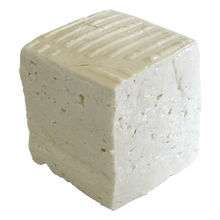 |
|
|
| Urdǎ |
 |
|
|
Russia
| Name |
Image |
Region |
Description |
| Bryndza |
 |
|
A crumbly salt cheese |
| Circassian cheese |
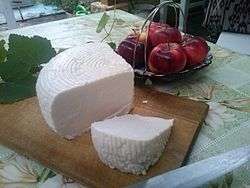 |
|
A crumbly non-melting and mild fresh cheese that is produced in the North Caucasus. It is a cultural cheese and staple for Circassians that is very famous in Russia (Republic of Adyghea, Kabardino-Balkaria, Karachay–Cherkessia, Shapsugia in the southern part of Krasnodar Krai, Stavropol Krai, North Ossetia, Moscow, and Saint Petersburg), and the Middle east countries (Jordan, Turkey, Lebanon, Syria, Israel) and worldwide (mainly countries that have a North Caucasians and Circassians Diaspora/s). |
| Korall |
|
|
A soft, processed cheese made of cow's milk |
| Tvorog (творог) |
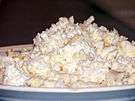 |
|
A firm quark version, somewhat similar to cottage cheese |
- Adygheysky
- Altaysky – a fairly dry hard cheese,[25] similar to Swiss cheese, originating in the Altai region
- Chyorny Altai – a hard cheese similar to cheddar
- Danilovsky
- Dorogobuzhsky – a soft cheese from western Russia
- Dorozhny
- Golandsky
- Gornoaltaysky – a hard, crumbly cheese[26]
- Kostromskoy [27]
- Moale
- Moskovsky – a hard cow's milk cheese, also similar to Swiss
- Medynsky
- Omichka – a slightly sweet, soft processed cheese made of cow's milk
- Pikantny
- Poshekhonsky – a hard cow's milk cheese
- Rossiysky – similar to German Tilsiter (ru:Российский сыр (Russian))
- Sovetsky
- Uglichsky – a hard cheese made of cow's milk
- Yaroslavsky – a hard cow's milk cheese, usually produced in rounds; with a slightly sour taste
- Zakusochny – a soft blue cow's milk cheese
Serbia
- Sremski
- Zlatarski[28] PDO
- Sjenički
- Svrljiški Belmuz [29]
- Krivovirski Kačkavalj[30]
- Homoljski ovčiji (Homolje sheep cheese)[30]
- Homoljski kozji (Homolje goat cheese)[30]
- Homoljski kravlji (Homolje cow cheese)[30]
- Pirotski Kačkavalj
- Lužnička Vurda
- Užički Kajmak
- Čačanski Kajmak
- Čačanski Sir
Slovakia
| Name |
Image |
Region |
Description |
| Bryndza |
 |
|
A sheep milk cheese made in Poland, Slovakia and Ukraine.[31] Recipes differ slightly across the countries. |
| Liptauer |
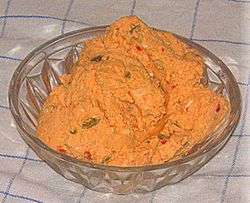 |
|
A spicy cheese spread made with sheep milk cheese,[24] goat's milk cheese, quark cheese or cottage cheese. |
| Ovčia hrudka[32] |
|
|
|
| Kravská hrudka |
|
|
|
| Korbáčiky |
.jpg) |
Orava |
A type of string cheese made from steamed cheese interwoven into fine braids. Common flavors include salty, smoked and garlic. |
| Oštiepok |
|
|
A traditional Slovakian smoked sheep milk cheese, it is a protected trade name under the EU's protected geographical indication. |
| Parenica |
 |
|
A traditional Slovakian cheese, it is a semi-firm, non-ripening, semi-fat, steamed and usually smoked cheese, although the non-smoked version is also produced. Parenica is cream and yellow in color, which is darkened by steaming. The cheese is produced in strips, which are woven into snail-like spirals. |
| Urda |
|
|
|
| Tvaroh |
|
|
|
Slovenia
- Bohinc Jože
- Nanoški
- Planinski
Spain
Sweden
| Name |
Image |
Region |
Description |
| Blå Gotland |
|
Stånga |
"Gotland Blue" is made in Sweden by the Arla Foods company in the town of Stånga on the island of Gotland. This cheese is often characterized as being somewhere between strong and mild, containing elements of both types. The color is a pale yellow, and it has no holes. |
| Grevé |
 |
|
A semi-hard Swedish cheese made from cow’s milk. It is similar to Emmental with a mild and nutty taste. The cream-coloured cheese has a smooth and creamy texture with large holes. It contains 30-40% fat and takes 10 months to attain full ripeness. |
| Gräddost |
|
|
|
| Herrgårdsost |
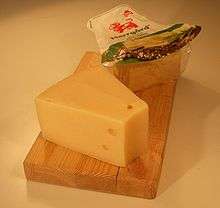 |
|
A semi-hard cheese made from cow's milk. The aged cheese has a mild, sweet, nutty flavor and small round holes. It is aged for three or four months, but often up to 12 or even 24 months. |
| Hushållsost |
|
|
A semi-hard cows'-milk cheese with small granular holes and aged around 60 days on average. The taste is described as mild yet somewhat sour. |
| Moose cheese |
|
Bjurholm, Sweden |
A cheese produced in Sweden from moose milk |
| Prästost |
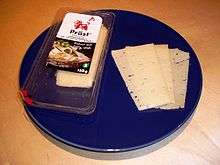 |
|
Made from pasteurized cow's milk. |
| Svecia |
|
|
A semi-hard cow's-milk cheese, with a creamy consistency, light yellow colour, small irregular holes, and a mildly acidic taste. The cheese is aged in a dry environment for at least two months, sometimes up to more than a year. |
| Västerbottensost |
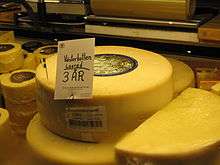 |
Burträsk |
A hard cow's milk cheese with tiny eyes or holes and a firm and granular texture. Strong in flavour, its taste is described as somewhat like Parmesan cheese, salty, but with more bitter notes. Västerbotten cheese must be aged for at least 12 months. Many Swedish people consider it the king of cheese. |
| Ädelost |
|
|
A blue cheese made from pasteurized cow's milk. It has a light cream color with evenly distributed blue-gray veins and a sharp, salty flavor. The cheese has a slightly moldy rind. |
Switzerland
Switzerland is home to about 450 varieties of cheese. Cows milk is used in about 99 percent of the cheeses produced. The remaining share is made up of sheep milk and goat milk.
Turkey
United Kingdom
The British Cheese Board[39] states that there are over 700 named British cheeses produced in the UK.
Ukraine
Middle East
Levant
| Name |
Image |
Region |
Description |
| Akkawi |
|
Acre |
A white brine cheese. It is named after the city of Acre, where it first originated, and is commonly made using cow milk, but can be also be made with goat or sheep's milk. |
| Areesh |
|
Originated in Egypt |
It is similar to cottage cheese. Shanklish, a fermented cheese, is made from areesh cheese.[40] |
| Baladi |
|
|
Soft-white, smooth, creamy cheese has a mild flavor. The cheese tastes delicious spread on fresh bread or crackers. It is eaten for breakfast or snacks. |
| Basket cheese |
|
|
Made from cow's milk, it's available fresh or dry. Fresh basket has no salt taste, while dry basket is mildly salty. Basket cheese gets its name from the way it is formed (inside a basket). |
| Charkassiye |
|
|
A soft, fresh cheese |
| Halloumi |
 |
|
a Cypriot semi-hard, unripened brined cheese made from a mixture of goat and sheep milk, and sometimes also cow milk.[41][42][43][44] It has a high melting point and so can easily be fried or grilled. It is noted for its ability to retain its shape under direct heat, or as a "grillable" cheese. |
| Jameed |
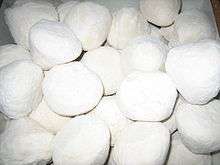 |
|
Hard, dry laban made from goat or ewe's milk.[45] Milk is kept in a fine woven cheesecloth to make a thick yogurt. Salt is added daily to thicken the yogurt even more and the outside of the yogurt filled cheesecloth is rinsed with water to allow any remaining whey to seep through. After a few days of salting the yogurt, it becomes very dense and it can be removed from the cheesecloth and shaped into round balls. Pictured is white Jameed in a shop front in Jerusalem. |
| Jibneh Arabieh |
|
|
A simple cheese found all over the Middle East. It is particularly popular in the Persian Gulf area. The cheese has an open texture and a mild taste similar to Feta but less salty. |
| Jibne Baida |
|
|
Arabic for white cheese, is a white hard cheese with a pronounced salty taste, often boiled before eating |
| Kashkawan |
 |
|
A type of yellow cheese made of sheep milk. In Albania, Bulgaria, Republic of Macedonia, Serbia and Romania, the term is often used to refer to all yellow cheeses (or even any cheese other than sirene). |
| Kashta |
|
|
is a heavy cream that is very popular in the Middle East. Traditionally, it is made by skimming the thickest part of the cream from whey. The product is used both as an ingredient in cooking and is mixed with honey to be eaten as an incredibly rich dessert. Rich Cow brand Kashta is a fresh, rich-tasting, cream product texture of which is smooth and thick. It has a sixty-day refrigerated shelf life. |
| Kenafa |
|
|
Is an unsalted, very fresh, soft cheese that melts easily and freely. It is used to make the popular "cheesecake", like dessert that is sometimes called Kenafa by people in the Middle East mainly Palestine. It can also be used as a base for other sweet cheese desserts. It is sold frozen because there is no salt in it and is available in both retail and bulk packages. |
| Labneh |
 |
|
Also known as Greek yogurt, labneh is a strained yogurt product that is common in the Middle East and the Levant. Pictured is Labneh in olive oil |
| Majdoule |
|
|
A salty white cheese made up of thick strands of cheese braided together (hence the name) |
| Nabulsi cheese |
 |
Nablus |
One of a number of Palestinian white brined cheeses made in the Middle East. Its name denotes its place of origin, Nablus[46] and it is well known throughout the West Bank and surrounding regions. |
| Shelal |
|
|
A salty white cheese made up of strands of cheese woven together |
| Surke or Shanklish |
|
|
a mature cheese made with spices and generally presented as balls of cheese covered in za'tar orchile powder; most often eaten as a starter dish with tomato, oil and sometimes onion |
| Syrian cheese |
|
|
There are numerous different kinds of Syrian cheese. A few of the most common include Ackawi, Baladi and Charkassiye. |
| Tzfat cheese |
 |
Safed |
A semi-hard cheese produced in Israel from sheep's milk. It was first produced by the Meiri dairy in Safed in 1840 and is still produced there by descendants of the original cheese makers. |
The Levant is a geographical region east of the Mediterranean Sea which includes the countries of Syria, Lebanon, Israel, Jordan, Palestine and sometimes it includes Cyprus and the Turkish province of Hatay
North America
Canada
| Name |
Image |
Region |
Description |
| Cheese curds |
 |
|
|
| Oka |
 |
|
Originally manufactured by the Trappist monks, who are located in Oka, Quebec, Canada, this cheese has a distinct flavour and aroma, and is still manufactured in Oka, although now by a commercial company. |
| Cheddar Cheese |
|
|
Most Canadian Cheddar is produced by a number of large companies in Ontario, though other provinces produce some and some smaller artisanal producers exist. The annual production is 120,000 tons. It is aged a minimum of three months, but much of it is held for much longer, up to 10 years. |
Central America
El Salvador
| Name |
Image |
Region |
Description |
| Cuajada |
 |
|
|
| Crema [47] |
|
|
A spreadable, unripened white cheese.[47] |
| Enredo |
|
|
|
| Queto |
|
|
|
Honduras
Nicaragua
Mexico
United States
Oceania
Australia
| Name |
Image |
Region |
Description |
| Tasty cheese |
|
|
Commonly mistaken as a variety of cheese due to the widespread use of tasty as an adjective for cheeses by Australian manufacturers; it is in fact equivalent to Cheddar, and is a term used in both Australia and New Zealand. Usage examples include CC's Tasty Cheese tortilla chips. |
New Zealand
South America
Argentina
Bolivia
| Name |
Image |
Region |
Description |
| Chaqueño |
|
|
|
| Menonita |
|
|
|
Brazil
| Name |
Image |
Region |
Description |
| Catupiry |
 |
|
A soft, mild-tasting cheese that can be spread over toasts, crackers and bread buns or used in cooking. Because of its low level of acidity, catupiry has become an ingredient in various dishes. It is one of the most popular "requeijão" (creamy cheese) brands in Brazil. |
| Minas |
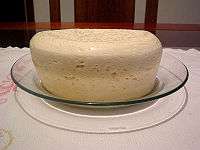 |
|
|
| Queijo coalho |
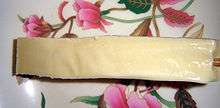 |
|
|
| Queijo de Colônia |
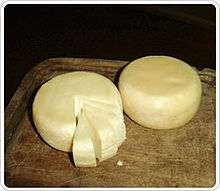 |
|
or Colony cheese. |
| Queijo Meia Cura |
|
|
|
| Queijo Canastra |
|
|
|
| Queijo Cobocó |
|
|
|
| Queijo-do-Reino |
|
|
|
| Queijo do Serro |
|
|
|
| Queijo Manteiga |
|
|
|
| Queijo prato |
|
|
|
| Requeijão |
 |
|
|
Chile
Colombia
| Name |
Image |
Region |
Description |
| Queso Campesino[52] |
|
|
|
| Questo Costeño[53] |
|
|
|
| Queso Cuajada[54] |
|
|
|
| Queso Paipa |
|
|
|
| Queso Pera |
|
|
|
| Quesillo |
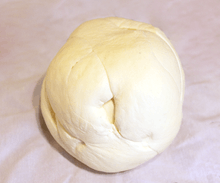 |
|
In Colombia, quesillo is a type of double cream cheese wrapped within a plantain leaf, made originally in the Tolima Department; the town of Guamo is most known for this dairy product. |
Venezuela
| Name |
Image |
Region |
Description |
| Guayanés cheese |
|
Guayana Region |
A soft, salty, white cheese. |
| Queso crineja [55] |
|
|
|
| Queso de mano [56] |
|
|
|
| Queso Llanero [57] |
|
|
Also known as prairie cheese and queso de año. |
| Queso Palmita |
|
|
A soft, watery, fresh white cheese with big holes, produced from pasteurized milk. It is usually made in large circular containers 6 feet in diameter and four feet in height. |
| Queso semiduro [58] |
|
|
|
| Queso telita [47] |
|
|
A mild farmer's cheese that is packaged in liquid.[47] |
Other
Some types of cheeses were either developed in various locales independently (usually as un-aged products from the beginning stages of dairy processing and cheesemaking), or are not actually cheese products. Examples include:
| Name |
Image |
Region |
Description |
| Cottage cheese |
 |
Various |
A cheese curd product with a mild flavor. It is drained, but not pressed, so some whey remains and the individual curds remain loose. The curd is usually washed to remove acidity, giving sweet curd cheese. Many local varieties exist. |
| Farmer cheese |
 |
Various |
Varieties of which are made in most cultures with a strong dairy culture |
| Smoked cheese |
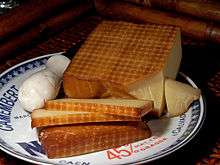 |
Various |
A style of preparing any number of hard or semi-hard cheeses, using smoke or smoke flavoring. Pictured is smoked Gruyère cheese |
| Soy cheese |
 |
|
Not a dairy product, but a cheese analogue made from soybeans/soy protein. Pictured is soy cheese manufactured to the consistency of a cream cheese. |
| Rice cheese |
|
|
As with soy cheese, an analogue from rice/rice protein |
Brands
| Name |
Image |
Region |
Description |
| Babybel |
|
Various |
Mini Babybel is known for its unique packaging, consisting of a netted bag in which each piece of cheese is encased in wax, with an outer cellophane wrapper. Numerous flavors of Mini Babybel are offered across the world |
See also
Articles by country
References
- ↑ "The History Of Cheese: From An Ancient Nomad's Horseback To Today's Luxury Cheese Cart". The Nibble. Lifestyle Direct, Inc. Retrieved 8 October 2009.
- ↑ Helou, Anissa (1998). Lebanese Cuisine. New York: St. Martin's Griffin. p. 18. ISBN 0312187351.
- ↑ "Biodiversity of Bacterial Ecosystems in Traditional Egyptian Domiati Cheese". The National Center for Biotechnology Information (U.S.), Applied and Environmental Microbiology.
- ↑ Mozzarella of the East: Cheese-making and Bai culture
- ↑ "Say cheese".
- ↑ "Indian entrepreneurs are churning out all varieties of gourmet cheeses".
- ↑ "History of Cheese". Retrieved 24 October 2016.
- ↑ "Cheese Club and Tartiflette Night at Seven Hotel". Retrieved 24 October 2016.
- ↑ indiacurry.com Fuzzy Math for reducing milk Retrieved 24 February 2008.
- 1 2 Culture Magazine (2012). Cheese For Dummies. John Wiley & Sons. p. 225. ISBN 1118099397
- ↑ "How to Make Pastillas de Leche from Carabao's Milk". 21 June 2014. Retrieved 24 October 2016.
- ↑ Text in this article was incorporated from the following public domain U.S. Government publication:
- Doane, C.F.; Hargrove, Robert C.; Lawson, H.W.; Matheson, K.J.; Sanders, G.P; Walter, Homer E. (1969). Cheese Varieties and Descriptions. U.S. Department of Agriculture. p. 72
- 1 2 3 "Wavreumont". Culture magazine. Retrieved 7 May 2013.
- ↑ Belgische kazen (Belgian cheeses) (Dutch/French)
- ↑ Like blocher and reblocher gave us the reblochon.
- ↑ , "Characteristics of major traditional regional cheese varieties of East-Mediterranean countries: a review", Efstathios Alichanidis & Anna Polychroniadou, Dairy Sciеnce & Technology, Volume 88, Number 4-5, July–October 2008
- ↑ Recio I, García-Risco MR, Amigo L, Molina E, Ramos M, Martín-Alvarez PJ (June 2004). "Detection of milk mixtures in Halloumi cheese". J. Dairy Sci. 87 (6): 1595–600. doi:10.3168/jds.S0022-0302(04)73313-5. PMID 15453472.
- ↑ Gibbs, Paul; Ria Morphitou; George Savva. "Halloumi: exporting to retain traditional food products". British Food Journal. 106 (7): 569–576. doi:10.1108/00070700410545755. Retrieved 14 December 2007.
- ↑ "Cyprus - Cultural life - Daily life and social customs - halloumi cheese.". www.britannica.com. Retrieved 16 June 2009.
Geography has left Cyprus heir to numerous culinary traditions—particularly those of the Levant, Anatolia, and Greece — but some dishes, such as the island’s halloumi cheese…are purely Cypriot
- ↑ Ayto, John (1990). The glutton's glossary: a dictionary of food and drink terms. Routledge. p. 133. ISBN 0-415-02647-4.
Haloumi, or halumi, is a mild salty Cypriot cheese made from goat's, ewe's, or cow's milk.
- ↑ Dew, Philip – Reuvid, Jonathan - Consultant Editors (2005). Doing Business with the Republic of Cyprus. GMB Publishing Ltd. p. 46. ISBN 1-905050-54-2.
Cyprus has managed to secure EU recognition of halloumi as a traditional cheese of Cyprus ; therefore no other country may export cheese of the same name
- ↑ Bousfield, Jonathan (1 April 2010). "The Rough Guide to Croatia". Penguin. Retrieved 24 October 2016 – via Google Books.
- ↑ Casasús, Isabel; Rogosić, Jozo; Rosati, Andrea; Stoković, Igor; Gabiña, Dunixi (26 March 2012). "Animal farming and environmental interactions in the Mediterranean region". Springer Science & Business Media. Retrieved 24 October 2016 – via Google Books.
- 1 2 Gundel, Karoly (1992). Gundel's Hungarian cookbook. Budapest: Corvina. ISBN 963-13-3600-X. OCLC 32227400.
- ↑ Sinclair, Charles Gordon (1 January 1998). "International Dictionary of Food and Cooking". Taylor & Francis. Retrieved 24 October 2016 – via Google Books.
- ↑ Sinclair, Charles Gordon (1 January 1998). "International Dictionary of Food and Cooking". Taylor & Francis. Retrieved 24 October 2016 – via Google Books.
- ↑ Refrigeration, International Institute of. "Bulletin: Annexe". Retrieved 24 October 2016 – via Google Books.
- ↑ Nova Varos Online - Zlatarski sir štiti - Švajcarska
- ↑ Cliquez ici pour le titre
- 1 2 3 4 http://www.zis.gov.rs/en/oznake_geografskog_porekla/ogp_spisak.html Archived 26 March 2009 at the Wayback Machine.
- 1 2 "Cheese Description: Bryndza". Cheese.com. Retrieved 11 June 2008.
- ↑ "Slovak Egg Cheese for Easter (Hrudka) Recipe". Retrieved 24 October 2016.
- 1 2 Fallon, Steve (1 January 2010). "Slovenia". Lonely Planet. Retrieved 24 October 2016 – via Google Books.
- ↑ Casasús, Isabel; Rogosić, Jozo; Rosati, Andrea; Stoković, Igor; Gabiña, Dunixi (26 March 2012). "Animal farming and environmental interactions in the Mediterranean region". Springer Science & Business Media. Retrieved 24 October 2016 – via Google Books.
- 1 2 Bogataj, Janez; Kvaternik, Rok (1 January 2007). "Taste Slovenia". Darila Rokus d.o.o./Rokus G. Retrieved 24 October 2016 – via Google Books.
- ↑ Tamime, Adnan Y. (15 April 2008). "Brined Cheeses". John Wiley & Sons. Retrieved 24 October 2016 – via Google Books.
- ↑ MobileReference (1 January 2007). "Travel Istanbul, Turkey: Illustrated City Guide, Phrasebook, and Maps". MobileReference.com. Retrieved 24 October 2016 – via Google Books.
- ↑ Guides, Rough (3 October 2011). "Rough Guide Phrasebook: Turkish: Turkish". Penguin. Retrieved 24 October 2016 – via Google Books.
- ↑ Ltd, Iconography. "British Cheese Board - Welcome". Retrieved 24 October 2016.
- ↑ Helou, Anissa (1998). Lebanese Cuisine. New York: St. Martin's Griffin. p. 18. ISBN 0312187351.
- ↑ Gibbs, Paul; Ria Morphitou; George Savva. "Halloumi: exporting to retain traditional food products". British Food Journal. 106 (7): 569–576. doi:10.1108/00070700410545755. Retrieved 14 December 2007.
- ↑ "Cyprus - Cultural life - Daily life and social customs - halloumi cheese.". www.britannica.com. Retrieved 16 June 2009.
Geography has left Cyprus heir to numerous culinary traditions—particularly those of the Levant, Anatolia, and Greece — but some dishes, such as the island’s halloumi cheese…are purely Cypriot
- ↑ Ayto, John (1990). The glutton's glossary: a dictionary of food and drink terms. Routledge. p. 133. ISBN 0-415-02647-4.
Haloumi, or halumi, is a mild salty Cypriot cheese made from goat's, ewe's, or cow's milk.
- ↑ Dew, Philip – Reuvid, Jonathan - Consultant Editors (2005). Doing Business with the Republic of Cyprus. GMB Publishing Ltd. p. 46. ISBN 1-905050-54-2.
Cyprus has managed to secure EU recognition of halloumi as a traditional cheese of Cyprus ; therefore no other country may export cheese of the same name
- ↑ Albala, Ken (25 May 2011). "Food Cultures of the World Encyclopedia [4 volumes]: [Four Volumes]". ABC-CLIO. Retrieved 24 October 2016 – via Google Books.
- ↑ Tamime, A. Y.; Robinson, R. K. (1991). Feta and Related Cheeses. Woodhead Publishing. p. 209. ISBN 1-85573-278-5. Retrieved 13 August 2012.
- 1 2 3 4 5 6 Castro, Lourdes (1 December 2009). "Eat, Drink, Think in Spanish: A Food Lover's English-Spanish/Spanish-English Dictionary". Potter/TenSpeed/Harmony. Retrieved 24 October 2016 – via Google Books.
- ↑ Fisher, John; Brown, Jules (5 April 2010). "The Rough Guide to Portugal". Penguin. Retrieved 24 October 2016 – via Google Books.
- 1 2 Bayless, Mr Rick (26 May 2009). "Authentic Mexican: Regional Cooking from the Heart of Mexico". Harper Collins. Retrieved 24 October 2016 – via Google Books.
- ↑ goliath.ecnext.com
- ↑ "South America: Buy 1 Online at igourmet.com". Retrieved 24 October 2016.
- ↑ (Spanish) Guia de procesos para la elaboracion de productos lacteos - Maria E. Pardo, F. Alamanza - Google Books
- ↑ (Spanish) Guia de procesos para la elaboracion de productos lacteos - Maria E. Pardo, F. Alamanza - Google Books
- ↑ (Spanish) Procesamiento de lácteos - ITDG-Perú - Google Books
- ↑ Angulo, Rafael Cartay (1 January 2005). "Diccionario de cocina venezolana". Editorial Alfa. Retrieved 24 October 2016 – via Google Books.
- ↑ Angulo, Rafael Cartay (1 January 2005). "Diccionario de cocina venezolana". Editorial Alfa. Retrieved 24 October 2016 – via Google Books.
- ↑ Angulo, Rafael Cartay (1 January 2005). "Diccionario de cocina venezolana". Editorial Alfa. Retrieved 24 October 2016 – via Google Books.
- ↑ (MAdrid), Fundación Alfonso Martín Escudero (1 January 2001). "Normalización y mejora de queso semiduro, tradicional y con reducido contenido en grasa, de leche de cabra". Fundación Alfonso Martín Escudero. Retrieved 24 October 2016 – via Google Books.
|
|---|
|
| Types | | |
|---|
|
| Animal milk | |
|---|
|
| Regions | |
|---|
|
| Special designations | |
|---|
|
| Organizations | |
|---|
|
| List articles | |
|---|
|
| Miscellaneous | |
|---|
|
|
|
|---|
|
| England | |
|---|
|
| Scotland | |
|---|
|
| Wales | |
|---|
|
| Northern Ireland | |
|---|
|
Manufacturers
& brands | |
|---|
|
| See also | |
|---|
|
|---|
|
| PDO | |
|---|
|
| PAT | |
|---|
|
Non-protected
varieties | |
|---|
|
| Manufacturers | |
|---|
|
|---|
|
| Individuals | |
|---|
|
| Manufacturers | |
|---|
|
| Miscellaneous | |
|---|
|
-
 Category Category
-
 Food portal Food portal
-
 WikiProject Food and drink WikiProject Food and drink
|





.jpg)

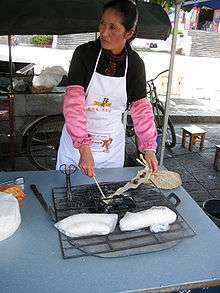








.jpg)







.jpg)





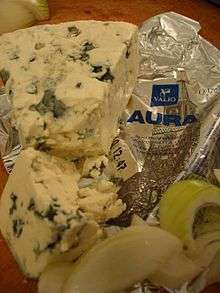
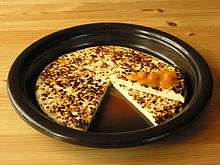










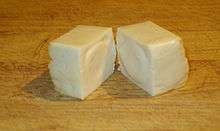
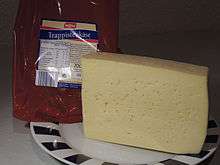

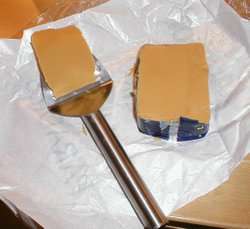
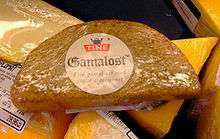
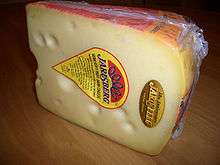
















.jpg)







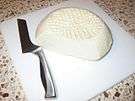










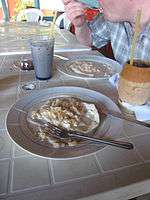

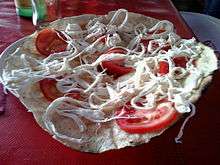
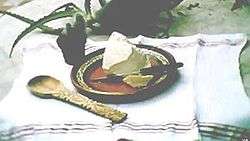


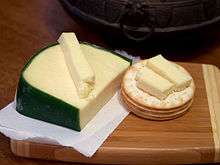



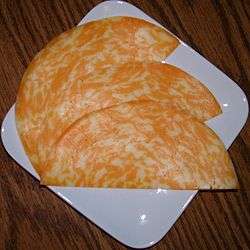



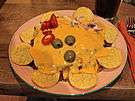
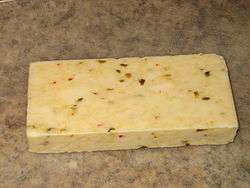

.jpg)
